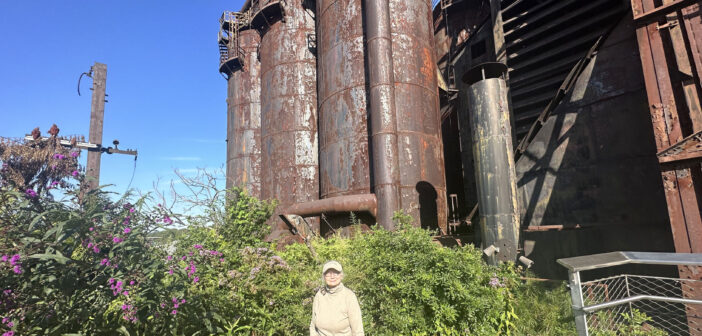Located in a city known for its role in the production of steel, Bethlehem Backyards for Wildlife has greener priorities for the community’s land.
According to the committee’s webpage, the group looks to support local biodiversity and minimize negative environmental impacts.
What started out as a neighborhood project is now a volunteer committee within the City of Bethlehem’s Environmental Advisory Council that led Bethlehem to become a National Wildlife Federation Certified Community Wildlife Habitat — which was the 62nd community in the country to do so, according to the federation’s blog.
In 2008, Martha Christine, founding committee member and Bethlehem resident, worked on encouraging neighbors in West Bethlehem to plant native trees and plants in their yards and planting strips.
“Non-native plants tend to be problematic because these plants will come into an area because they are so aggressive,” committee member Jane Cook said. “They basically invade and push out the native plants.”
Cook said some of the priorities of the group are to encourage people to plant native plants in Bethlehem and to increase public awareness about the importance of these plants such as Brown-eyed Susan and Baptisia.
Roseanne Amano is a founding member of the Bethlehem Backyards for Wildlife.
“Even if you drive along the highway, you can look on the side and you see how many invasive vines and plants are taking over,” Amano said.
In 2016, to celebrate the 275th anniversary of Bethlehem’s founding and the 100th anniversary of the combined city — which consists of Bethlehem, South Bethlehem, and West Bethlehem — the committee received a grant to plant 100 trees in conjunction with the Mount Airy Neighborhood Association.
According to committee member and West Bethlehem resident Christine Roysdon, the committee received a grant from the Department of Community and Natural Resources in 2017 for the West Bethlehem Rose Garden. The money received was used to transform the park through the implementation of winding paths throughout the park, the placement of a permeable surface instead of asphalt and the addition of native trees.
Lehigh County has also given the group money throughout the years to add native plants to the Rose Garden. Roysdon noted that roses are less likely to become diseased if they are interplanted with other plants.
Roysdon also mentioned the committee received a grant last summer from the state government to plant a small set of native plants in Madison Park located on the South Side.
Ilse Stoll, a rural pioneer who used perennial flowers and other native plants as an alternative to annuals or non-native plants, was integral to the group’s success with the Hoover Mason Trestle Gardens. She was a Master Gardener, meaning she underwent a rigorous educational program, through The Pennsylvania State University’s Extensions program, for proficiency in all areas of gardening.
“(Stoll) was especially instrumental in getting Backyards for Wildlife and other volunteers involved in the Hoover Mason Trestle Gardens,” Roysdon said.
Located next to the Steel Stacks and 46 feet above the ground, the Hoover Mason Trestle runs approximately 2,000 feet long and contains 10 garden beds.

One of the signs at the Hoover Mason Trestle dedicated to the Bethlehem Backyards for Wildlife. The sign recognizes the efforts to maintain the native gardens. (Victoria Moya/ B&W Staff)
The city hired Patrick Cullina, who designed and developed the Highline in Manhattan, to design the garden beds. Cullina decided to mainly incorporate non-native plants into the design of the Hoover Mason Trestle.
Following the completion of the work, Stoll realized no one was taking care of the plants. She informed the city of Bethlehem that irrigation alone was not enough to maintain the garden beds.
Stoll requested the city pay $1,000 to the Master Gardeners program at Pennsylvania State University’s campus extension and offered the help of the Bethlehem Backyards for Wildlife group.
During the summer, the group meets every three weeks to tend to the garden beds, weeding out invasive species.
When the freeze begins in the winter, meaning that frost covers the plants, the plants go into their dormant state. In this state, plants are in a “resting” period where they lose their stems and leaves but roots remain and regrow in the spring. When this state occurs, the groups cut the plants down, leaving what the pollinators can use. These pollinators include bees, birds and insects that are integral to the spread of pollen. A final cleanup takes place in the spring, one the pollinators have done their work, and the cycle begins again.
The group refers to these meeting periods on the trestle as their “Hoover Mason Trestle Gardening Days” where volunteers are welcomed to help tend to the plants.
In addition to this, as the non-native plants die, the group replaces them little by little with thriving natives. The preservation of native plants is especially important to the survival of the native pollinators, given the current stresses they are under.
Cook said, due to urban development in Bethlehem, a lot of sources of pollen for these pollinators are gone.
“Every time you plant a native plant, in your yard or at your business, you are helping these pollinators do their job,” Cook said.
Bethlehem Backyards for Wildlife is welcoming new volunteers to participate in gardening days and other group events. The next Hoover Mason Trestle Gardening Day will be held at 10 a.m. on Oct. 10.






Comment policy
Comments posted to The Brown and White website are reviewed by a moderator before being approved. Incendiary speech or harassing language, including comments targeted at individuals, may be deemed unacceptable and not published. Spam and other soliciting will also be declined.
The Brown and White also reserves the right to not publish entirely anonymous comments.
1 Comment
As the yearly climate changes will what classifies as a native plant change? What are the native plants that are to be encouraged?